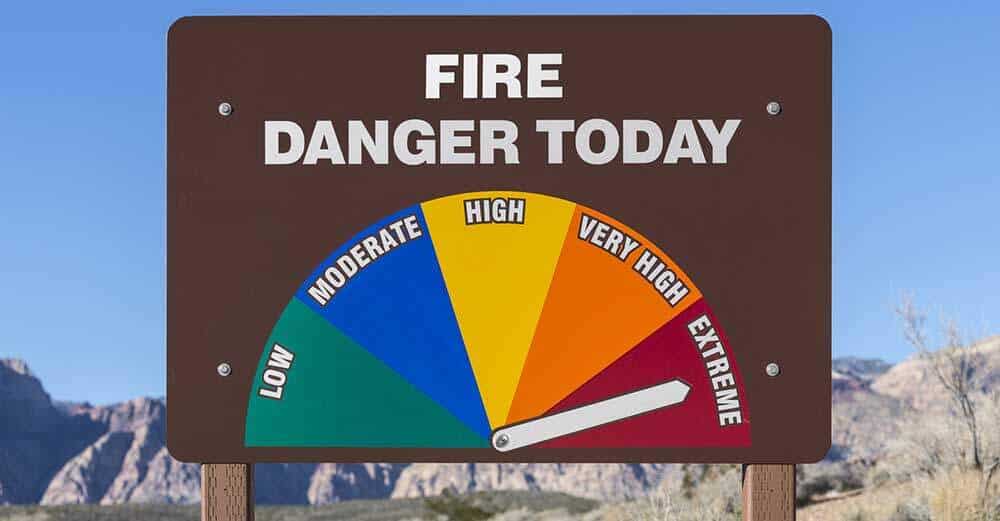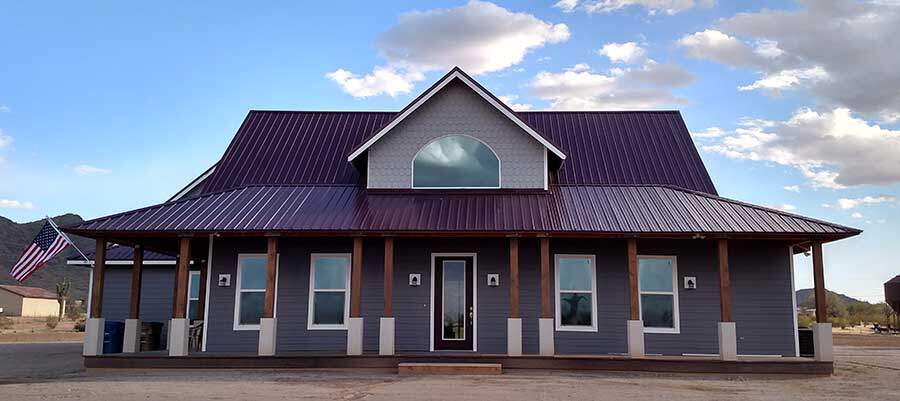As temperatures climb and lawn furniture makes a seasonal appearance, most people are excited by summer’s approach. But, for those living in wildfire regions, the sunny weather also brings the apprehension of whether this might be the year wildfire threatens their home.

In California, 2018 brought the most destructive fires in the state’s history, but 2017 was one for the record books too, and concerns are strong for what fires of the future will bring. The reality is that wildfire seasons are starting earlier and ending later, while burning hotter. As fire seasons heat up, homeowners are thinking of how to improve their home’s chances if wildfire closes in.
For a Roof, Metal is The Safest Choice
While no building material is perfect, metal roofing is frequently recommended as one of the best products, along with slate and terra cotta, for resisting fires. But unlike slate and terra cotta, metal roof fends off heavy snowfalls and high winds of 120 miles an hour and more.
The seamless nature of metal roofing is what prevents it from ripping off as windstorms bear down. This is also part of how metal roofs help defend against severe wildfires; most people know that winds can speed up a fire’s spread, but wildfires can also generate localized wind, and what’s called a “fire whirl,” which is essentially a tornado of wind and fire, capable of shooting flames and even burning logs and other debris a considerable distance.
What makes even light winds so destructive in a forest fire is their ability to carry ash and embers up to a mile away. This is notorious for being the cause of fires spreading so far, so quickly in some cases, like in California’s Carr Fire of 2018, which exploded from 40,000 acres on fire to 80,000 in a single day.

Embers and Roofs
Asphalt roofs are America’s top roofing choice, but that’s not because they’re the best product to use – it’s because they’re economical and easy to install. But they’re also a huge reason why homes go up in flames so quickly. Cedar shingles and asphalt are both fuel for fire, and asphalt literally is – it’s a petroleum-based product and, while some engineering advances have helped its fireproofing abilities, it doesn’t stay that way for the life of the roof. The older these products get, the more fire-vulnerable they become. Enter one wind-blown ember and fire can erupt.
That’s where metal roofing makes all the difference. Age doesn’t reduce the fire-resistance of metal – it can’t dry out, it doesn’t break down. That’s why FEMA has recommended Class “A”-rated metal roofs for wildfire-prone regions since 2008.
Metal roofs do require attention during fire season, as they can conduct heat, so it’s important to keep roofs clean of needles and leaves, but this is true of asphalt and other roofing as well. Beyond that, a standing-seam metal roof is built to protect your home from embers and winds.
Meet the Hausers : The Last Home Standing
Metal roofing comes in so many styles and colors now, that a homeowner doesn’t need to sacrifice curb appeal for safety. But the roof can’t do everything if a yard isn’t maintained in a fire-smart way, even if it might put a damper on aesthetics.
It was fire-safety first and aesthetics second that defined Randall Hauser’s home and yard design when he built his dream home in 1994. That fire-safety-forward design of his home and yard is why, despite living in Redding, California’s blue oak and pine forest, his home was literally the only structure that survived in his area of the deadly 2018 Carr fire. More than 1,500 structures burned nearby, but not Hauser’s metal-roofed home.
By the time the fire was finished, it would be California’s 7th-largest fire and 7th-most destructive in history, killing eight people and consuming nearly 230,000 acres of woodland and communities. It took five weeks to contain it and 1,604 buildings were destroyed, in $1.7 billion of damage.
So why did Randall Hauser’s home survive when all 17 of his neighbors lost theirs?
When asked to examine Hauser’s house for why he had such success in surviving, County Director and Forest Advisor Yana Valachovic wrote for UC’s Cooperative Extension Forestry that, “The house includes a well-maintained, simple, “Class A” metal roof. The house did not have dormers (i.e., small rooms that project from the roof) or other, more complex roof designs. I’ve seen several homes, that despite having metal roofs, did burn. In many of those instances, accumulated leaf litter in the gutters gave fire an entry point into the home.”
- Source: Fifteen Hundred Structures Gone, but Not This One
- Related: Does Wildfire Mitigation Work? 16 Examples and Counting
Following all the guidelines for installing a metal roof can save your structure, and your life. Randall Hauser did that, and more, when they built their home in 1994, and it’s why his home still stands.
More Survivor Stories
Watch the miraculous story of how two family homes in Washington survived a catastrophic wildfire thanks to proper planning and a metal roof
Beyond the Metal Roof
We’ll help you pick all the right materials for the best fire-resistant roofing solution, and then it’s up to construction, maintenance, and yard care. Here are some other guidelines to help you be a survivor when fire comes your way.
- While having hedges and other vegetation around the house’s perimeter can look beautiful, it’s a fire risk. Hauser and others who survive wildfires use a non-combustible perimeter. Five feet is a good width. Have gravel, concrete or crushed-rock perimeter and walkways around the home. Remember, even bush roots can spread fire underground, and anything that can bring the fire right up to your home is a threat.
- Keep grass short and raked when it’s dry, to help keep fire’s travel limited.
- Maintain and prune all trees in the yard. Keep them strong and healthy. If fire does spread, the last thing you want are weakened branch-ends flinging up against your home. Try to have low-growing plants closer to the home, and if you’re in hot regions, succulents and cacti are good for these.
- Have boxed-in or soffited eaves with outside-edge venting. The latest fire safety recommendations are to use 1/8th-inch mesh screen in attic and foundation vents. All this is to prevent embers and sparks from finding their way via wind, where they can ignite dry inner-home materials.
- House siding is an important consideration too, and anywhere there are lap joints and gaps can mean fire vulnerabilities. Stucco and brick are great exterior materials. But most important is good maintenance.
- Have easily-accessed and highly-visible exterior water sources so that firefighters can find water quickly in a fire. The Hausers had their hoses and faucets labelled with reflective signs.
From Firewise USA, Even More Tips for Around the House
Before a wildfire threatens your area you should consider looking at and mitigating the following elements around your property:
- Clear leaves and other debris from gutters, eaves, porches and decks. This prevents embers from igniting your home.
- Remove dead vegetation and other items from under your deck or porch, and within 10 feet of the house. Learn more about the basics of defensible space on the Firewise website.
- Screen or box-in areas below patios and decks with wire mesh to prevent debris and combustible materials from accumulating.
- Remove flammable materials (firewood stacks, propane tanks) within 30 feet of your home’s foundation and outbuildings, including garages and sheds. If it can catch fire, don’t let it touch your house, deck or porch.
- Wildfire can spread to tree tops. Prune trees so the lowest branches are 6 to 10 feet from the ground.
- Keep your lawn hydrated and maintained. If it is brown, cut it down to reduce fire intensity. Dry grass and shrubs are fuel for wildfire.
- Don’t let debris and lawn cuttings linger. Dispose of these items quickly to reduce fuel for fire.
- Inspect shingles or roof tiles. Replace or repair those that are loose or missing to prevent ember penetration.
- Cover exterior attic vents with metal wire mesh no larger than 1/8 inch to prevent sparks from entering the home.
- Enclose under-eave and soffit vents or screens with metal mesh to prevent ember entry.
- Learn more about how to protect your home and property at www.firewise.org.
Questions? Need pricing?
Please call us toll-free at 1-877-833-3237
with any questions or quote needs! We are here to help.
Customer service and pricing available from 8:00 am to 5:00 pm MST Monday – Friday.





